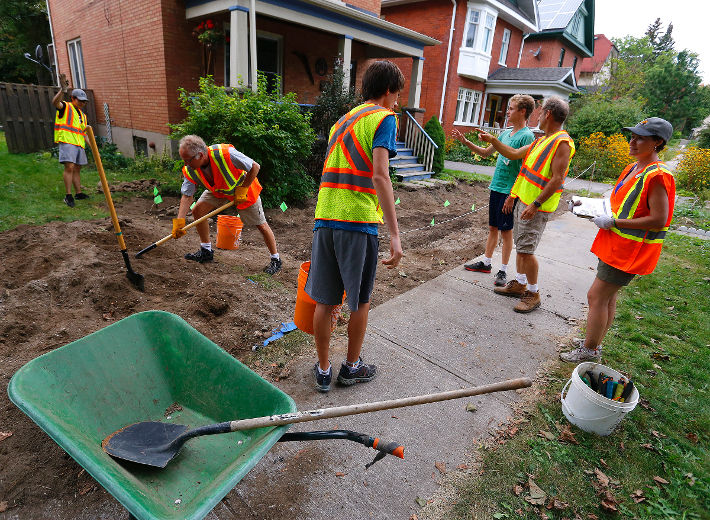The Umbrella Stormwater Bulletin

Flood-prone neighbourhoods take action with Groundbreakers
Photo: Volunteers in Peterborough install a rain garden
If you’re out for a walk in the Avenues neighbourhood of Peterborough, the Castlegreen housing cooperative in Thunder Bay, or the Kingscourt neighbourhood of Kingston, you might notice some new gardens sprouting up.
These communities are taking a partnership-based approach to addressing repeated flooding and water quality issues. Municipalities, neighbourhoods, and non-profits are working together to manage rain where it falls on public and private property.
Flooding is complicated and caused by a number of factors. But property owners can take responsibility for their own runoff and make sure they are not contributing to stormwater problems, while at the same time protecting their own basements. This is the idea behind the Groundbreakers project, created by Green Communities Canada in partnership with Ecosuperior, Red Squirrel Conservation Services, and Green UP, along with the cities of Thunder Bay, Kingston and Peterborough. The project brings neighbours together to manage rain where it falls, and was made possible by support from the Ontario Trillium Foundation.
In total, 21 rain gardens were installed in these three flood-prone neighbourhoods, on both public and private property. The gardens were professionally designed, and installed by over 100 volunteers, mostly from the neighbourhoods themselves. Municipalities provided in kind contributions of materials and equipment, and located sites for some of the gardens on public property. The installations are expected to divert over 600 m3 of stormwater from storm sewers annually, keeping over 100 kg of pollutants (suspended solids, oil, grease, lead, nutrients) out of waterways.
“I think historically, everyone’s thought of stormwater runoff as kind of a nuisance they want to get it off their property as quickly as possible. With programs like this where you get people installing rain barrels and rain gardens, they start to think of runoff and stormwater as a resource, something they can use on their own property,” says Ian Boland, Stormwater Systems Coordinator with the City of Peterborough. “In doing that, they’re helping to alleviate some of the concerns with the city’s infrastructure, they’re helping to reduce flooding and just improve the water quality going to our local creeks.”
While Groundbreakers only installed a handful of gardens in each neighbourhood, revisioning sessions with residents, business owners, and city staff identified many more opportunities for green infrastructure. The next step will be to look for ways to install more.
There is often a debate about the role of green infrastructure in reducing flooding – when municipal infrastructure is failing, engineered measures will still be needed. But by safely absorbing as much runoff as possible into the ground where it is taken up by plants and returned to groundwater aquifers, property owners can make sure they aren’t making flooding problems worse.
“What we want to do at the neighbourhood level is engage everyone to understand that they can get the water away from their foundations without passing it on to their neighbours or into the stormwater system,” says Sharyn Inward, Green Communities Canada Director of Water Programs and originator of the Groundbreakers program. “Now that we’ve demonstrated what’s possible, we’ll work on getting every house managing rain where it falls.”

